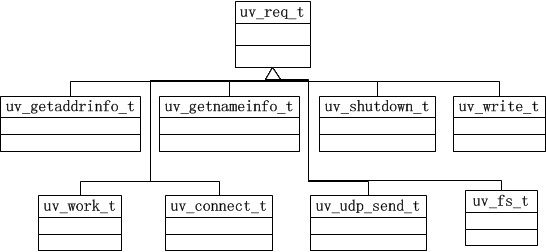asynchronous function
多线程实现异步函数
基础结构
struct uv_req_t

struct uv_getnameinfo_t

struct uv_async_t

struct uv_loop_s
struct uv_async_t; // See above
struct uv__async {
uv__async_cb cb;
uv__io_t io_watcher;
int wfd;
};
struct uv_loop_s {
... ...
void* wq[2]; // work queue
uv_mutex_t wq_mutex; // work queue mutex
uv_async_t wq_async; // work async handle
... ...
void* async_handles[2]; // async handle queue
struct uv__async async_watcher; // async watcher
... ...
};
In general, these members are divided into three groups:
- Work queue wq is to store finishing working works.
- Async handle wq_async is a handle, it defines in struct uv_loop_t, then its life cycle is the same as the loop. While initial the loop, wq_async is inserted into async_handles.
- Async watcher async_watcher contains a uv__async_cb cb, a uv__io_t io_watcher, a int wfd. io_watcher registers to loop->watchers. At this struct, there are two callback functions. That one does I/O, another do async events. At the second callback, it will call all handles in async handle queue async_handles. Notes: In Linux, io_watcher.fd is created by eventfd(), instead of pipe() or pipe2().
libuv currently uses a global thread pool on which all loops can queue work on. 3 types of operations are currently run on this pool:
- Filesystem operations, see asynchronous-fs
- DNS functions (getaddrinfo and getnameinfo)
- User specified code via uv_queue_work()
libuv 通过多线程的方式来实现异步调用同步函数。
异步实现getaddrinfo、getnameinfo,获取到结果后,通过线程间发送消息通知网络线程。
流程:(request的传递 + loop的回调)
uv_getaddrinfo -> uv__work_submit(loop,
&req->work_req,
uv__getaddrinfo_work,
uv__getaddrinfo_done); -> thread::worker -> uv__getaddrinfo_work -> getaddrinfo -> uv_async_send
-> uv__async_io -> uv__async_event -> uv__work_done -> uv__getaddrinfo_done -> typedef void (*uv_getaddrinfo_cb)(uv_getaddrinfo_t* req,
int status,
struct addrinfo* res);
uv_getnameinfo -> uv__work_submit(loop,
&req->work_req,
uv__getnameinfo_work,
uv__getnameinfo_done); -> thread::worker -> uv__getnameinfo_work -> getnameinfo
应用层调用 uv_getaddrinfo、uv_getnameinfo,函数内部会产生一个 work request,这个 request 会被放入到线程间的共享队列里。
loop的回调:uv__async_io -> uv__async_event -> uv__work_done -> uv__getaddrinfo_done。
线程的创建:程序启动时创建的网络I/O线程,即主线程。在第一次调用 uv__work_submit 时,通过 pthread_once 的方式只一次创建所需要的异步工作线程,默认创建4个异步工作线程。
多个异步工作线程,竞争地从 work request queue 获取 work request,获取成功,调用 request 设置的 work 函数,即实现具体功能的同步函数(getaddrinfo 、getnameinfo),然后发送消息通知网络I/O线程,异步完成了对应函数的调用,返回了结果。
异步工作线程与网络I/O线程间的通讯:
- 采用共享队列,像上面的 work request queue,类似生产者与消费者模型,网络I/O线程产生request,异步工作线程处理request。这种模型要求消费者线程不停低检查是否有新的request到达,为实现高效,一般采用 mutex lock + condition variable 。 网络I/O线程主动与异步工作线程通讯时采用的是这种方式。
- 管道 pipe。libuv 的异步工作线程在完成 work 之后,就是通过 pipe 的方式发送消息通知网络I/O线程,异步调用完成了,网络I/O线程可以继续做后面的逻辑。之所以采用这种方式,是因为网络I/O线程主逻辑就是在调用 epoll_wait 等待各种事件,实现 pipe 的通讯,只需要把 pipe 一端 fd 的读事件加入到 epoll 的监控列表。
Linux 线程间 pipe 通讯,两个线程可以都使用同一个 fd :
#if defined(__linux__)
if (fd == -1) {
static const uint64_t val = 1;
buf = &val;
len = sizeof(val);
fd = wa->io_watcher.fd; /* eventfd */
}
#endif
do
r = write(fd, buf, len);
while (r == -1 && errno == EINTR);
if (r == len)
return;
异步工作线程通过 pipe 给网络I/O线程发送消息后,uv__async_io 被调用,是因为在对应的 fd 上注册了这个回调函数:
uv__io_init(&wa->io_watcher, uv__async_io, pipefd[0]);
uv__io_start(loop, &wa->io_watcher, UV__POLLIN);
wa->wfd = pipefd[1];
wa->cb = cb;
work request 的创建和销毁:
- 创建:uv_getaddrinfo_t getaddrinfo_req;
- 销毁:uv__getaddrinfo_done -> xxx_cb -> uv_freeaddrinfo(addrs) -> freeaddrinfo(ai)
uv_getaddrinfo_t is a subclass of uv_req_t.
typedef struct uv_getaddrinfo_s uv_getaddrinfo_t;
uv_getaddrinfo_s is a request object for uv_getaddrinfo.